8+ Sample Direct Marketing Plan
-
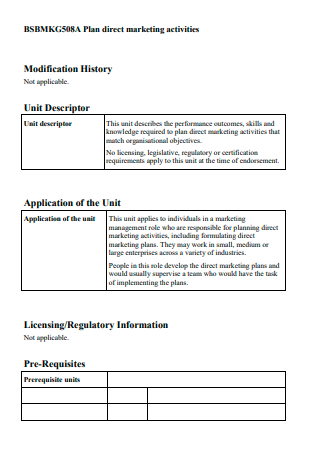
Direct Marketing Activities Plan
download now -
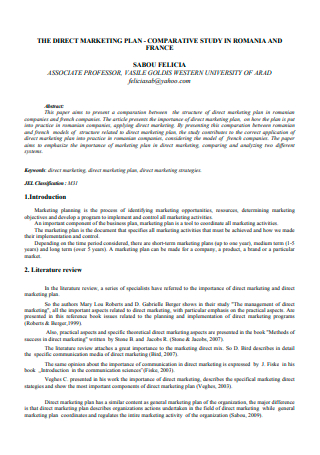
Direct Marketing Plan in PDF
download now -
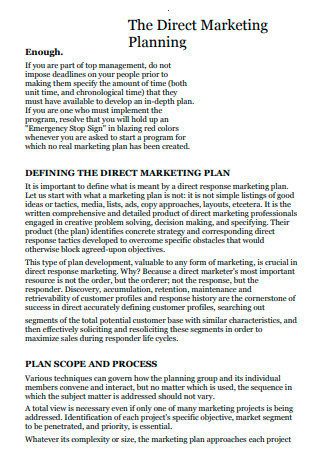
Basic Direct Marketing Planning
download now -
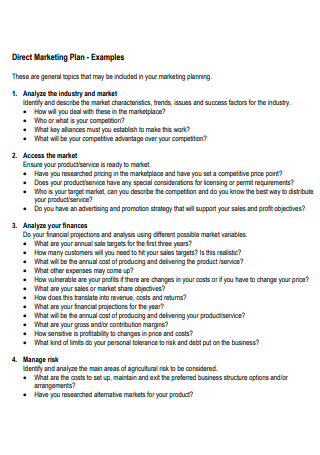
Direct Marketing Plan Example
download now -
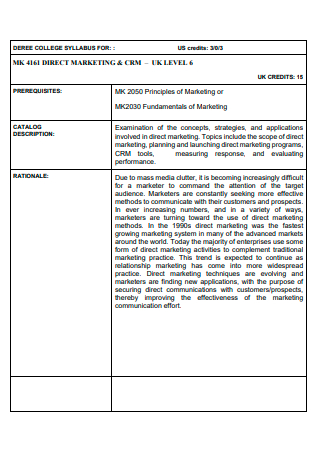
Standard Direct Marketing Plan
download now -
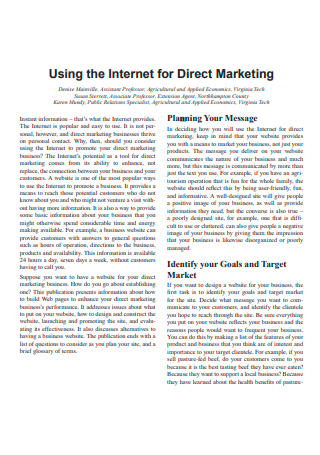
Printable Direct Marketing Planning
download now -
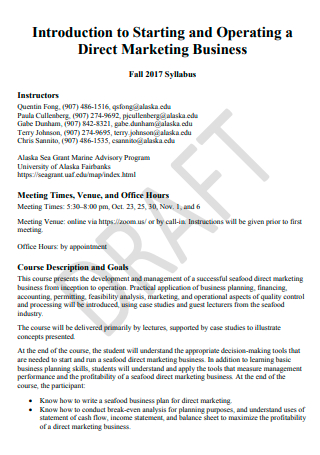
Draft Direct Marketing Business Plan
download now -
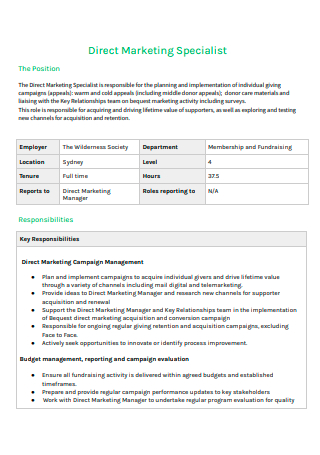
Direct Marketing Specialist Planning
download now -
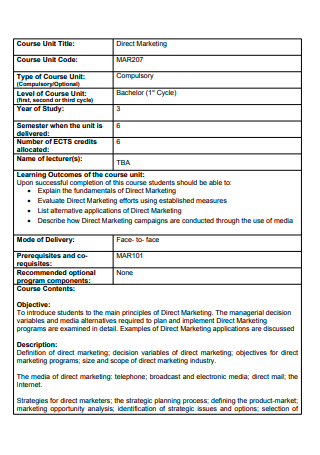
Simple Direct Marketing Plan
download now
FREE Direct Marketing Plan s to Download
8+ Sample Direct Marketing Plan
a Direct Marketing Plan?
Benefits of Direct Marketing
Types of Direct Marketing
How To Build a Direct Marketing Campaign
FAQs
How are direct marketing techniques defined?
How effective is direct marketing?
Are newsletters truly effective?
What Is a Direct Marketing Plan?
To grasp the concept of direct marketing, you must first get the concept of indirect marketing. All strategies that promote your brand on a broad basis are classified as indirect marketing. Billboards, commercials, newsletters, blog posts, radio ads, Google ads, brand awareness initiatives, and newspaper ads are all examples of this. These advertisements are not tailored to the individual but rather try to attract a target audience with comparable interests. On the other hand, direct marketing is focused on the end customer, to convert them or move them farther down the funnel. Direct marketing encompasses a wide range of online and offline approaches. Email marketing, targeted adverts, remarketing, and SMS marketing is examples of online strategies. Telemarketing, events, points of sale, and postal mail are examples of offline approaches. Research shows that your marketing budget should be calculated as a percentage of your income. A general rule of thumb is that B2B businesses should allocate between 2% and 5% of their revenue to marketing. For B2C companies, the amount is frequently higher—between 5% and 10%.
Benefits of Direct Marketing
Direct marketing strategies that are effective focus on a single product or service and encourage clients to take action – to request additional information, register their interest, visit your website, make a booking or purchase. Direct marketing enables you to offer your products and services directly to the clients who require them most. On the other hand, direct marketing efforts involve meticulous planning and a thorough awareness of appropriate natural marketing practices. Being aware of the benefits of direct marketing will enable you to employ it effectively. With that, here are some of its other benefits:
Types of Direct Marketing
1. Direct Mail
Direct mail is the process of communicating information about your business using either a physical address (mail or flyers) or an email address. Direct mail might take the form of sending a special offer or free sample, advertising a sale, reminding customers about a service, or informing customers about your products or services. One significant advantage of direct mail campaigns is their ability to be customized, tested, and measured. Without a doubt, the mailing list is the most critical component of every direct mail operation. You risk losing precious time and money if you deliver your work to the wrong audience.
2. Social Media
Rarely can a business afford to ignore social media? It is not solely a commercial endeavor. There are compelling reasons to have a presence on the platform used by your target consumers. Among the benefits are increased brand recognition and the capacity to deliver quick and responsive client service. Additionally, social media can help you increase website traffic, generate revenue, and improve your search ranking. Naturally, social media platforms will not reach every customer. To create a tailored social media campaign, you must first understand your audience.
3. Email
Email marketing allows you to send targeted and personalized communications to your clients, thereby fostering meaningful relationships. Additionally, it might increase the response rate to your direct marketing initiatives.
4. Catalogues
Catalog marketing is a type of direct marketing in which consumers order things online or from a printed catalog rather than visiting a retail establishment. Almost half of all consumers in the United States shop via catalog or online. Catalogs from a single firm feature products from a single company that processes orders, ships the merchandise, and provides customer care. Multiple Company catalogs offer products from various firms, allowing smaller businesses with fewer products to utilize this form of direct marketing.
5. Direct Response Advertising
The purpose of direct answer advertising is to encourage people to buy something immediately from your ad. A direct mail piece with a postage-paid response card to order a product, a television commercial with a toll-free phone number, and an email with a link to order the product from your website are examples of this.
How To Build a Direct Marketing Campaign
While many marketers nowadays choose indirect marketing, this does not mean you should abandon direct marketing. Direct marketing is far from being an obnoxious method of the past, as long as you know how to adapt your plan to the present scene. Rather than that, it can be an excellent approach to increase consumer engagement and build rapport with prospective buyers by tailoring your message to their interests. The following are some steps to optimize your plan and maximize the benefits of direct marketing:
-
Step 1 Identify your intended audience.
Direct marketing might appear overbearing compared to outbound techniques and inbound marketing, which allow consumers to initiate contact. However, your approaches do not have to be aggressive. Unlike outbound marketing, which broadcasts your message to a large audience, successful direct marketing is highly targeted. Rather than promoting an obtrusive message to a small number of people, focus your marketing efforts on those already interested. Your letter should directly address a particular segment of your audience, providing them with an experience tailored to their wants and desires. According to some studies, 80 percent of consumers are more likely to purchase from a brand that offers this level of customization, which helps raise conversion rates. With a well-defined target market, you can maximize your Return On Investment while keeping your direct marketing spend modest (ROI).
-
Step 2 Make sure your marketing plan is quantifiable.
The secret to a successful direct marketing strategy is determining when success occurs. Consider which measures can serve as indicators that your objectives are being reached. Consider tracking the number of people who sign up for your service due to a direct mail campaign or the consumer response rate to an SMS campaign. Measuring your plan will assist you in determining why your clients aren’t responding to your direct marketing efforts. Even throughout your campaign, you’ll be able to change your approaches to inspire your audience to act. After your campaign concludes, this well-documented data can assist your team in gaining a clear picture of what transpired. For instance, you may see a pattern regarding which languages provide the highest click-through rates or which channels generate the most consumer interactions.
-
Step 3 Be direct.
Direct marketing is not invisible. While indirect marketing frequently disguises advertisements as beneficial information, direct marketing is typically highly promotional. Because you’re attempting to elicit action quickly, you should be rather candid about your ambitions via a clear CTA or sales pitch. Direct marketers who succeed use a customer-centric strategy by developing a call to action that is both unique and relevant to their target audience. As long as customers understand what you want them to do and the benefits they will receive, you are well on your way to developing an efficient direct marketing campaign.
-
Step 4 Preserve relationships.
Your direct marketing efforts do not have to — and should not — end once you have converted individuals of your target demographic. This marketing style is highly effective at connecting with your customers, as you are directly engaging them. Buyers may create an emotional connection to your brand over time, resulting in increased consumer loyalty. Direct marketing tactics that are most effective are capable of reactivating consumers. Segmenting your audience according to their stage in the buyer’s journey is one way you can utilize. This avoids selling to existing clients with a sales presentation they have already heard. You’re providing more incentives for customers to return, whether it’s a new product or offer.
-
Step 5 Utilize your data to help you refine your approach.
While we’ve already stated that your direct marketing plan should be measurable, your metrics can be used for more than determining the success of a single campaign. When you sit down and evaluate the numbers from multiple drives, you can identify tendencies. With these trends in mind, you’ll be able to determine which channels and messages are most effective with your buyers. This information can be used to make important choices about future direct marketing campaigns. Additionally, if customers return, your Data Report about them will grow. By leveraging information about your customers, you may curate a direct marketing message for each individual more precisely. For instance, accumulating data enables you to adopt more effective cross-selling strategies that align with buyers’ interests, increasing client lifetime value over time.
FAQs
How are direct marketing techniques defined?
Direct marketing is a method for businesses to advertise directly to the public about their product or service. Direct marketing techniques include direct mail, telemarketing, and email marketing. Additionally, companies must segment their target consumers appropriately to be successful.
How effective is direct marketing?
Direct marketing is effective because it allows for the targeted distribution of customized content to a specified audience. Because you are not targeting a large audience, this sort of marketing might be cost-effective. The initial cost of launching these initiatives will be lower than that of typical marketing.
Are newsletters truly effective?
Newsletters are an excellent vehicle for accomplishing all of these goals. The secret to a successful newsletter is to make it unique and informative. It might feature information about the local community and serve as a showcase for new items or services. If you design and distribute newsletters digitally, success is highly quantifiable.
Direct marketing is built on communicating directly with prospects and consumers, which allows for a close relationship. And, while direct marketing’s objective is to raise market awareness and educate consumers about the products and services you offer, the primary aim is to persuade prospects to make a purchase directly from you without the assistance of a third party.
